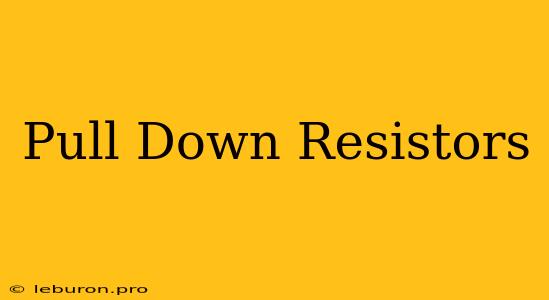The Essential Role of Pull-Down Resistors in Electronic Circuits
Pull-down resistors are a crucial component in many electronic circuits, playing a vital role in ensuring proper signal behavior and preventing unexpected states. These resistors, connected between a signal line and ground, provide a path for current to flow when the signal is not actively driven high. This seemingly simple addition can have a significant impact on the performance and reliability of a circuit, making understanding their purpose and application essential for any electronics enthusiast or professional.
Understanding Pull-Down Resistors: Basics and Function
What are Pull-Down Resistors?
A pull-down resistor is a resistor connected between a signal line and ground, effectively providing a path for current to flow to ground when the signal is not actively driven high. This means that the signal will be pulled down to a low state in the absence of an active signal.
Why Use Pull-Down Resistors?
Pull-down resistors address a common problem in digital circuits: floating inputs. When a digital input is left unconnected or not actively driven by a signal, its state is undefined. This can lead to unpredictable behavior, as the input could be interpreted as a high or a low state by the circuit, causing malfunctions.
Here's where pull-down resistors come into play:
- Define a Default State: By connecting a pull-down resistor, the input is pulled down to a low state when no signal is present, providing a defined initial condition.
- Prevent Glitches: In circuits with multiple inputs, a floating input can cause unwanted voltage spikes or glitches, potentially disrupting the circuit's operation. Pull-down resistors eliminate this issue by ensuring the input is always at a low state when not actively driven.
- Improve Signal Integrity: By providing a path to ground, pull-down resistors can also help dampen noise and improve the overall signal quality, leading to more reliable circuit performance.
Key Considerations for Selecting Pull-Down Resistors
Choosing the appropriate pull-down resistor involves considering several factors:
- Input Impedance: The pull-down resistor value should be low enough to dominate the input impedance of the device it's connected to. This ensures the resistor effectively pulls the signal down to a low state.
- Power Consumption: A lower resistance value will draw more current, leading to higher power consumption. Therefore, it's essential to balance the need for effective pull-down with power efficiency.
- Signal Rise Time: The resistance value affects the signal rise time, as it determines how quickly the signal can transition from low to high when driven by a signal source. Higher resistance values can lead to slower rise times.
- Noise Sensitivity: Lower resistance values can make the signal more susceptible to noise, while higher values offer better noise immunity.
Applications of Pull-Down Resistors
Pull-down resistors find wide application in various types of electronic circuits:
1. Microcontrollers and Logic Gates
Pull-down resistors are essential when working with microcontrollers and logic gates. By providing a defined low state for unused inputs, they prevent unpredictable behavior and ensure reliable operation. This is especially critical in circuits with multiple input pins that may not be actively driven at all times.
2. Push-Button Switches
In circuits using push-button switches, a pull-down resistor is often placed in parallel with the switch. When the button is not pressed, the resistor pulls the signal line to a low state. When the button is pressed, it overrides the resistor, driving the signal high. This configuration simplifies the design and ensures the signal is always defined.
3. Input Protection
Pull-down resistors can also be used to protect sensitive inputs from damage. In situations where external signals might be connected to an input pin, a pull-down resistor can help prevent unwanted high voltages from reaching the device, providing an additional layer of safety.
4. Tristate Buffers
Tristate buffers are used to enable or disable a signal line, effectively acting as a switch. In a tristate buffer circuit, a pull-down resistor is often used to provide a low state when the buffer is disabled. This ensures a defined low state for the signal line, even when the buffer is not actively driving the signal.
5. Open-Collector and Open-Drain Devices
Open-collector and open-drain devices have an open collector or drain output, requiring an external pull-up resistor to provide a path to a high voltage when the device is not active. Pull-down resistors are used in parallel with the output to provide a path to ground when the device is active, enabling proper operation of the circuit.
Conclusion: The Importance of Pull-Down Resistors
Pull-down resistors are a crucial component in many electronic circuits, playing a vital role in defining signal states, preventing glitches, and improving overall circuit reliability. By understanding their purpose and how to select the appropriate resistor value, designers can ensure their circuits function correctly and consistently. Whether it's working with microcontrollers, logic gates, push-button switches, or other types of circuits, pull-down resistors remain a fundamental element for achieving reliable and predictable behavior.
